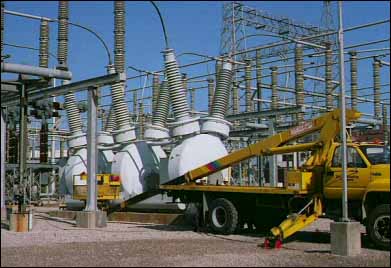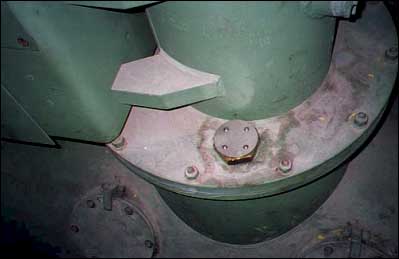SF6 Leak Repairs without Pressure Reduction
The conventional way of reducing the leakage is to deenergized the circuit breaker, remove the SF6 gas, replace the leaking gaskets and/or other equipment, refill the circuit breaker with SF6 gas, and reenergize. The problem with this procedure is the very high cost of the repair, and the long downtime of the equipment. Sometimes the downtime runs into weeks. There is also the possibility the circuit breaker will be contaminated internally during the maintenance, or the possibility of misadjusting of the moving parts as the breaker is reassembled.
Many of the older breakers are experiencing leaks around the bushing flanges and tops of the porcelains, requiring the removal of the bushing for gasket replacement. The removal of the bushings causes changes in the internal adjustment of the circuit breaker and always provides the possibility mistakes can be made in adjustments during the reassemble of the bushings in the breaker.
Unfortunately, it is not only the bushings, which are leaking, but also other assemblies within the circuit breaker, such as the safety overpressure diaphragms. Some of the piping leaks can be repaired simply by tightening the connection, but this does not solve the problem with other leaking areas, including tank porosity for cast low voltage tanks and welds in fabricated tanks.
Polytech Services Corp. has developed a procedure, which addresses these problems and can solve the leakage problems without reducing the gas pressure or extended downtime.
A recent case involved an SF6 substation at Florida Power & Light on Miami Beach. This was an older ring bus substation with four circuits. It was leaking gas profusely. A check for leaks indicated the major leaks were at the safety diaphragms. After removing the top covers from the diaphragms, it was discovered the lead alloy diaphragms had multiple pin holes from corrosion activity over a period of time, and one diaphragm had a split in the scribe mark on the diaphragm used to initiate a break under excessive pressure. Leakage was sufficient to blow the leak detection fluid approximately 3 feet into the air.
One phase of the ring bus was being deenergized for other reasons, so it was decided to install new relief diaphragms in two of the three phase tanks while the circuit was out of service. Polytech Services Company's Engineer was called in to determine the possibility of stopping the leaks, or of making recommendations to solve the problem. Polytech's Engineer with concurrence from FP&L, recommended temporarily stopping the leaks in the three worse leaking relief diaphragms by plugging them with a casting material. This was done and the long-term solution was examined.
In order to replace the 12 relief diaphragms would require the gases in all circuits to be removed from the units, and new diaphragms installed. This was decided against as it was found the two new relief diaphragms were already leaking. The cost of $3,000/relief diaphragm was not insignificant, but the cost of manpower and equipment to remove and replace the gas would be excessive.
Polytech Service's Engineer offered to design a simple spring-loaded relief valve to fit over the present leaking relief diaphragm assembly. These could be installed without removing or lowering the gas pressure. This plan was approved and within two weeks the 12 relief diaphragms, fitted with the spring-loaded relief valves were installed and the leaks were sealed, maintaining the safety features of the units. It was estimated that over $50,000 was saved on this installation by performing the repairs without interfering with the operation of the substation, and not requiring the removal of the gas from the breakers.

Since that time, Polytech has developed and utilized several unique methods and hardware for stopping SF6 leaks without reducing pressure in the circuit breaker. Removing a small amount of the bushing gasket between the porcelain and the metal with a special tool now repairs bushing leaks. A quad ring with a nylon backup ring saturated in a flexible hardening material replaces the removed gasket material. The gas is allowed to leak through a micro valve fitted into the groove while the quad ring is being permanently bonded in place. After the sealing material is in place and permanently set, the micro valve is turned off, and the leak is permanently sealed. The entire procedure when done in the field normally takes 2-3 hours per bushing.

This same basic process is used on tank leaks. The tank surface is prepared by removing any surface contamination. The area around, (but not over the leak), is built up with a polymer ceramic material to obtain a solid, permanent bond to the metal. The micro valve is then bonded to the polymer ceramic material, while the leak is allowed to continue through the micro valve to prevent any pressure build up which might dislodge the seal between the micro valve and the polymer ceramic material. Once the bond is set, (usually about 5 minutes), the micro valve is shut off and the leak is permanently sealed. The procedure is executed without reducing pressure, and is completed in less than an hour. This procedure is also applicable to oil leaks on transformer and breaker tanks.
Edited By Stephen Heiser and John McKnight
